Do You Know Suzy Lake?
Kathleen Reichelt
November 2017
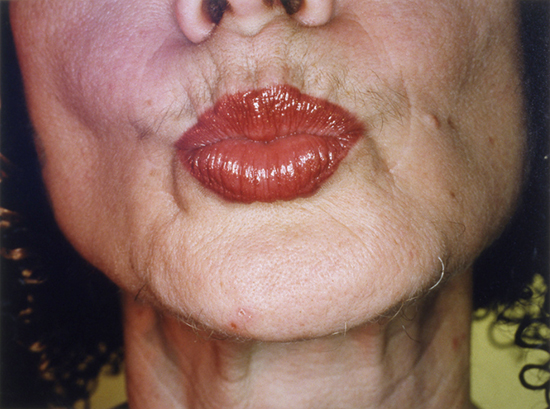 Pucker, 2001, digital chromogenic print
Pucker, 2001, digital chromogenic print
Image courtesy Suzy Lake and Georgia Scherman Projects
It is a warm, wet spring day in March 2016, when I meet my friend Nicole in downtown Montreal. She has flown in from Switzerland, and I’ve driven two hours east to see her. We’ve known each other for almost two decades, our friendship built upon mutual interests in art, philosophy, feminism and coffee. We jump right into these topics when we reunite, making our way down the slippery Ste-Catherine Street, stopping under awnings to avoid the occasional downpour, headed to the Belgo building. We always come here when we meet in this city. The Belgo is a six-story building in the Quartier des spectacles district, filled with art galleries, artist workshops, dance, yoga and martial arts studios. The building dates back to 1913, when it once housed a department store, while today it is filled with Canadian contemporary art.
In Galerie Donald Browne we stop in to check out a group show. I’m thrilled to see two works for sale by Suzy Lake. The American-born photographer is someone I came across in a museum back in the 2000s, where her influential work from the 1970s was being shown. Discovering an artist’s work in a museum feels a little dusty next to seeing their work in a commercial gallery. Maybe it is the potential for ownership, that capitalist driven desire to consume. I pull my friend over to where one of Lake’s pieces is hanging high up on the wall. It is from her series “Beauty at a Proper Distance / In Song”, 2001. The photograph is an extreme close up of a puckered, bright red mouth and chin of a woman. At first glance it resembles a popular advertisement one might see for lipstick or make-up products, but looking more closely I see the distinct facial hair and lines on the face. The photograph is bold and defiant, challenging the idea of beauty and the visibility of aging in women. It speaks to consumption and socially acceptable portrayals. Aren’t women supposed to age gracefully? Isn’t facial hair the taboo of all women? Something we apparently are not supposed to possess according to the mainstream images of women we are exposed to, outside of art spaces.
The second work of Lake’s is from the artist’s “Transformations” series. “Suzy Lake as Francoise Sullivan” is part of the artist’s earlier work, addressing identity politics and performance in photography. It is the work that made a huge impact on what we consider contemporary photography today. Its been said before, but worth mentioning again, that Suzy Lake’s early works influenced Cindy Sherman’s iconic “Untitled Film Stills” of 1979. Now you’re thinking “Oh, that Suzy Lake.” Right. Lake wasn’t on the shelves when I was studying women artists, but today we know her work.
Suzy Lake was born in Detroit, Michigan. The artist studied fine arts at Wayne State University and Western Michigan University in Kalamazoo from 1965 – 68, at which time she became involved with the civil rights movements of the 60s. Following the Detroit Race Riots of 67, Lake immigrated to Canada with her husband in 1968. Settling in Montreal, Lake became active in the early conceptualist art scene, co-founding the artist-run gallery Véhicule Art Inc. In the early 1970s, Lake began performing for the camera. The artist’s role playing would prod at the questions of self and identity. The early works are shot in direct, black and white style, referencing body and gender. The images are early feminist work.
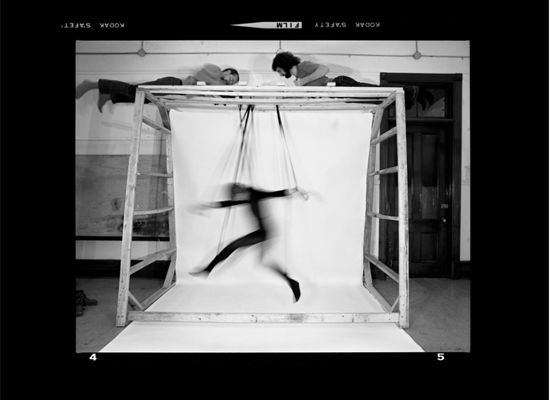 Choreographed Puppet #4.5, 1976/2007-2015, chromogenic black and white print
Choreographed Puppet #4.5, 1976/2007-2015, chromogenic black and white print
Image courtesy Suzy Lake and Georgia Scherman Projects
Lake was one of the first women artists in Canada to adopt performance, video and photography in exploring the politics of gender, identity and the body. It wasn’t until 1993, that she was the subject of a major mid-career retrospective, Point of Reference, at the Canadian Museum of Contemporary Photography. Since, Lake has been part of international exhibitions including WACK! Art and the Feminist Revolution (L MOCA and tour, 2007-08) Identity Theft: Eleanor Antin, Lynn Hershman, Suzy Lake, 1972-1978 (Santa Monica Museum of Art, 2007), Held Together With Water (Sammlung Verbund, Vienna and tour, 2008) and Traffic: Conceptual Art in Canada 1965-80 (2010). In 2013, Suzy was awarded the Dazibao artist book prize and launched Suzy Lake: Performing an Archive in 2015. In 2014 the Art Gallery of Ontario presented a full-career retrospective with a substantial book titled Introducing Suzy Lake. In 2016, Lake was awarded the Governor General’s Award in Visual and Media Arts.
Acknowledgement of Lake’s early work and the four decades of her contribution to contemporary art has secured her place in the canon of Canadian art history, and a spot on the international stage. It is easy to crush on Lake’s early work, which is both radical and nostalgic in its stylishly black and white way. But for me, the image of the woman with red lips and facial hair has the greatest urgency. Maybe it is because I am no longer an art student, of the twenty something bracket, that I (can) feel and relate to this image. Yes, it is playful, but also sobering in it’s direct look at aging. Beyond the questioning of beauty is the idea of death. Not an idea used to sell products for lipstick or moisturizer. A full frontal, brightly lit, stage for mortality. It is there for me to see, but that will come later. My first response to this work, standing in the Montreal gallery with my friend, is of camaraderie. This image inspires bonds and story telling between women.
Nicole and I dive right in. Each of us telling how, at some point in our lives, we were directed by others as to how to look and behave. Both of us having heard remarks about smiling more, wearing lipstick, or other things that the other, whoever they might be, felt entitled to comment on. Often times the comments came from male friends, and we were not only the recipients of the male gaze, but of male correcting, as well. The correcting, adjusting, manipulating of specifics, to fit the mould of what is acceptable, what is attempting to be beautiful, or passable at the very least. As we relay our personal and biographical responses to this work of Suzy Lake’s, it occurs to me just how much this artist’s work has pulled from us. The image of the aged face, bright lips and sprouts of facial hair would continue to occupy space in my brain for the next year, until an opportunity arises for me to discuss the work with the artist.
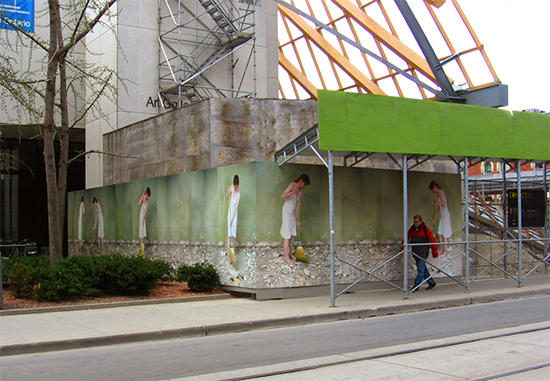 Rhythm of a True Space #1 Installation, AGO, Toronto, 2008
Rhythm of a True Space #1 Installation, AGO, Toronto, 2008
Image courtesy Suzy Lake and Georgia Scherman Projects
K: My first question is how do you talk about what you are working on now?
Suzy Lake: It is difficult to talk about my work in its very early stage. My work is generally generated by a series of ‘irritations’ that accrue without a deliberate attempt to tie them together until a potential image materializes. From there, I adjust/work the image to represent the distillation or common denominator of the original ‘irritations’. The distillation zeros in on the over-arching concept or dilemma, and tends to drop any biographical references. I can talk about the work (and develop it to a final stage) when the the concept becomes clear.
K: Are these irritations captured or documented in the camera, and something you see when reviewing the images? Or does your process involve other methods for discovering/digging up or creating these irritations? (ie. journaling, sketching, reading current news)
Suzy Lake: The ‘irritations’ happen from different directions. They are often personal and small, and would feel inconsequential to name out loud; however, they challenge my power. Thus I notice them. But they are not always small; and when I see them ‘in the world’ – such as reading current news, power dynamics in the workplace or manipulative identity representation, I see the relationship of the small things to them. I think it is important to provide the viewer with an entry they might feel is on their own terms when constructing the image, so the experience of the small things become valuable to represent the individual.The challenge is then to drop that personal and bring the dilemma under the larger umbrella of the dilemma. I do make notes on the irritations or possible materials that make sense. I sometimes make a minimal sketch or photograph to have a bag of tricks to work with once the project has taken form.
K: In your series “Beauty at a Proper Distance”, you have provided an artist statement on your website that finishes with “Plucking post-menopausal facial hair is something I can do that Brittany Spears cannot do – yet.” Is humour a result and/or strategy in approaching irritations? Does it contribute to dropping the personal and enlarging the umbrella of the dilemma?
Suzy Lake: Sometimes when consumerism or youth cultures’s assumptions and persistent mis-representat
K: In an interview you had in 2015, during your show at the AGO, you talked about your recent work being more quiet and politically more poetic. That you could trust that coming out in the work more. Could you speak further about the poetic in your work, and how the poetic has developed or changed with this trust you mentioned?
Suzy Lake: I think my work shifted in the mid-nineties. Instead of the work responding to a direct power dynamic, my issues included more of a context to the dynamic. I think I employ more perceptual strategies to keep the viewer engaged with a piece so the fuller conceptual narrative can reveal itself. Comments during exhibiting these works seemed to confirm that the subtleties were actually being read as qualities of the issue. Audiences may or may not be able to name these elements, but it was clear to me that they expressively received them.
K: A rather general question, but, why do you think our culture is interested in photographing ourselves?
Suzy Lake: Ha, ha… existentialism was such a dirty word from the 80’s until recently. Yet portraiture was such a salient feature of the first half of the 20th century. It revealed self- expression, the angst of war or political injustice. Although selfies affirm we exist in the world, they are idealistically orchestrated to describe appearance. That may serve a valuable purpose, but it doesn’t ask any critical questions about our world.
K: There is a clip online produced by the AGO on your Performing Haute Couture. Could you describe how your studio practice is different or similar to this? Do you apply your own make-up, lighting, would your assistant help with these details?
Click to watch: Suzy Lake: The Making of ‘Performing Haute Couture
Suzy Lake: This is not typical of my production. I normally do my own lighting and camera set-up. I do direct my assistant. In this case, I wanted the shots to look more commercial than I could do on my own. However, the movement techniques were my own design, and I was fortunate that my photographer Miguel Jacob was willing to accommodate all my aesthetic direction.
K: Could you share what a typical studio day might be for you? Or if there even is a typical studio day? Is there an ideal, perhaps?
Suzy Lake: I don’t think there’s a typical studio day for me. When I am working on a new series, I may jump up from something with my camera to test an image or technique. It could be that while doing errands, I see a perfect location to do a shoot. Other times it can feel more practical such as getting a particular back drop paper, assembling props, etc.. Much production time is spent in Photoshop either doing modest colour corrections or major assemblages. What may be unfortunately more typical of the last 5 years is the administrative catch up I’ve had to do on my inventory and provenance of my work. I’m also doing a fair bit of interviews with grad students that are investigating early feminism or early conceptual art in Canada.
K: How does talking, writing and other communications and/or exchanges inform your performance?
Suzy Lake: I am always interested in how viewers read or respond to my work. It is important to me to see how viewers receive my concepts on their own terms – or if their terms stray from my intent. I am excited by a good writer when they articulate how nuances of my perceptual strategies add to the development of the work.
K: How structured, private or collaborative is that process for you?
Suzy Lake: I lecture a lot, so the questions are reflective of their response to the work. I don’t have a lot of studio visits, so I’m not sure how private my process actually is. Idea conversations and visual readings are great, but I am not interested in a formal critique or corrective suggestions. I prefer to solve the “what’s working” and “what’s not working” on my own terms. I do not collaborate on projects with other artists very often.
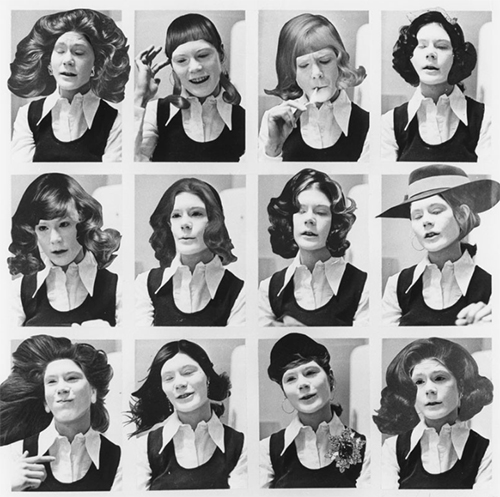 Miss Chatelaine, 1973/1996, gelatin silver, selenium toned, fiber-based print
Miss Chatelaine, 1973/1996, gelatin silver, selenium toned, fiber-based print
Image courtesy Suzy Lake and Georgia Scherman Projects
K: When I was a student and looking for a woman artist to write my paper on, I remember one shelf in the library with maybe two dozen books. What was it like for you starting out? Who were your early influencers?
Suzy Lake: The only female in the art department of my undergraduate programme was an art historian. I was a ware of a few women abstract painters, but I was moving away from painting. As I looked at the Judson Dance Troupe, I began to discover a few women performance artists like Adrian Piper.
K: In the past few years you’ve had a solo exhibition at the AGO, were awarded the prestigious Governor General’s award for Visual and Media Arts and were a finalist for the Scotiabank Photo Award. What impact have these, or other acknowledgements, had on your career? Can you point to a time in your career, or practice, that was especially significant?
Suzy Lake: I think what might be significant is that I had to earn a living. I taught, and that freed me from the expectation to sell. I could make the art I wanted. But yes, to receive such prestigious awards after a long practice made me feel that I had contributed to the field beyond my own art-making pleasure. It was magic.
K: I’m sure I’m not alone in hoping this is a long way off, but, is retirement something you consider? I know some artists who have retired from teaching, but continue on with practicing their art form. Still others who continue with activism, but have retired their studio practice. What are your thoughts on this?
Suzy Lake: I thought I was retiring in 2008 when I left teaching. But I think the effects of the historical feminist shows brought my work into a bigger arena. My studio practice spent most of my time looking back for participation in these exhibitions. I am enjoying what I do, and looking forward to making new work.
K: In another interview, I asked the artist what he would say to an artist just starting out. I’m curious what you would say to a mid-career artist?
Suzy Lake: Ha, ha… By mid career, you’ll see that many appear to have ‘made it’. By default, one wonders or has doubt. I say ‘just hang in there’. External validation is wonderful, but make the work you want so you already have a reward. The art world is fickle, and you never know…
Going through my own digital photographs, I find the picture I took at the gallery last year, of my friend standing next to Lake’s “Suzy Lake as Francoise Sullivan”. Nicole is making a face. She is performing through play. Though it isn’t our intention to document this day or this moment for the future, I remember that we took it, and I dig it out of the archives. I play with the photograph in Photoshop. Change Nicole’s eyes and scribble with a digital pen. It is both tribute and document. To an artist who made and makes an impression on us. Who shifts the conversation to what we see with our own eyes.
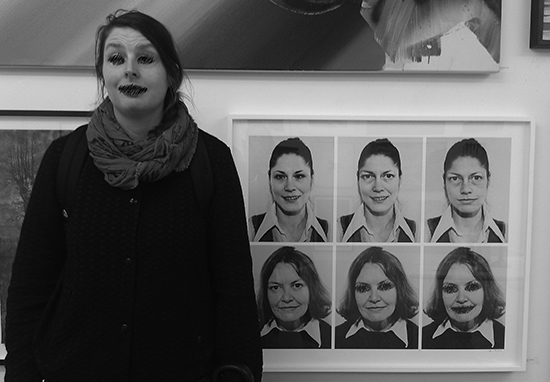 Image courtesy of Kathleen Reichelt
Image courtesy of Kathleen Reichelt
Click here to visit Suzy Lake’s website
